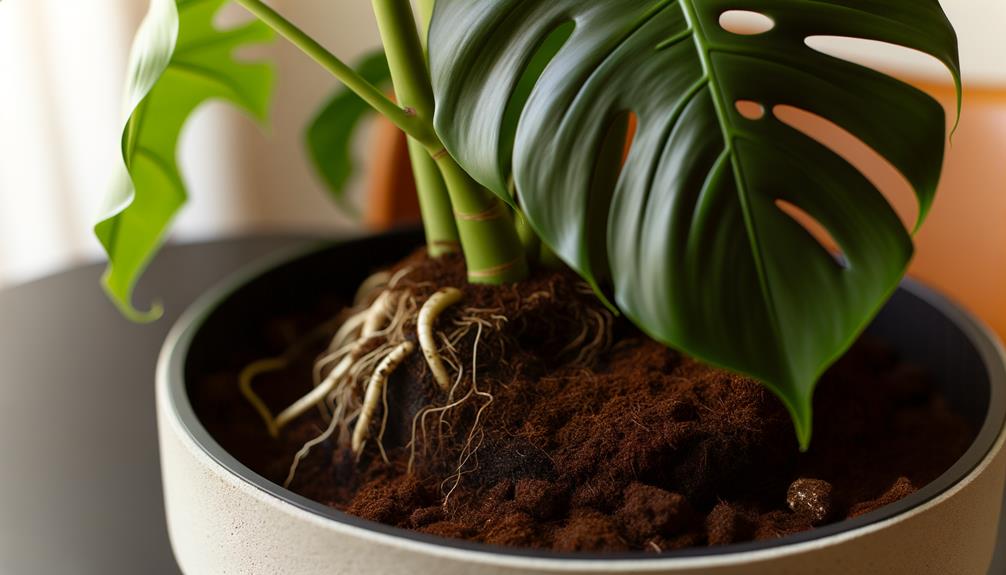Best Fertilizer for Monstera Deliciosa: A Complete Guide!
The finest fertilizer for Monstera Deliciosa is a balanced formula with equal parts nitrogen, phosphorus, and potassium, such as a 10-10-10 mix. This composition supports lush foliage, root development, and complete water regulation.
Both organic and synthetic options are suitable; organic fertilizers improve soil health with slow nutrient release, while synthetic ones provide immediate nutrient availability. Fertilize every 2-4 weeks during the growing season and reduce frequency in dormancy.
Slow-release options and liquid fertilizers can also be effective if applied correctly, ensuring consistent nutrient supply. For a thorough approach to nurturing Monstera Deliciosa, further details are advantageous.

Key Takeaways
- Balanced fertilizers with equal N-P-K ratios such as 10-10-10 or 14-14-14 promote overall plant health and growth.
- Organic slow-release fertilizers enhance soil structure and provide sustained nutrient supply.
- Liquid fertilizers ensure swift nutrient uptake and can be applied during regular watering routines.
- Fertilizer spikes offer a low-maintenance, gradual nutrient release method ideal for steady plant nourishment.
- Homemade fertilizers like banana peel tea and eggshell powder are sustainable and enrich the soil naturally.
Importance of Fertilization

Fertilization plays an important role in the growth and health of Monstera Deliciosa by providing necessary nutrients that support various physiological processes. These nutrients are essential for cellular functions such as photosynthesis, respiration, and synthesis of complex molecules like proteins and enzymes.
Fertilizers supply macronutrients such as nitrogen, phosphorus, and potassium, which are critical for robust leaf development, root growth, and overall plant vigor. Additionally, micronutrients like iron, manganese, and zinc, although required in smaller amounts, are crucial for enzymatic reactions and chlorophyll synthesis.
Regular fertilization guarantees that Monstera Deliciosa maintains its characteristic lush foliage and vigorous growth. Understanding the role of fertilization aids in implementing practices that enhance the plant’s resilience against diseases and environmental stress.
Understanding Nutrient Needs
Monstera Deliciosa requires a balanced supply of essential macronutrients to support its vigorous growth and lush foliage. These macronutrients include nitrogen, phosphorus, and potassium. Additionally, the plant benefits from micronutrients such as iron, magnesium, and calcium, which play vital roles in various physiological processes.
Understanding these nutrient needs is essential for selecting the appropriate fertilizer and ensuring the best plant health.
Essential Macronutrients
Understanding the important macronutrients namely nitrogen, phosphorus, and potassium—is essential for maximizing the growth and health of Monstera Deliciosa.
Nitrogen supports leafy growth and is vital for photosynthesis, making it necessary for the plant’s large, iconic leaves.
Phosphorus is integral for root development and energy transfer within the plant, promoting strong root systems and overall vigor.
Potassium enhances water regulation, disease resistance, and enzyme activation, contributing to the plant’s resilience and nutrient uptake efficiency.
An ideal fertilizer for Monstera Deliciosa will typically have a balanced N-P-K ratio, such as 20-20-20, ensuring each macronutrient is available in adequate amounts.
Understanding these macronutrient roles allows for informed decisions, ensuring Monstera Deliciosa thrives in diverse growing conditions.
Micronutrient Importance
Beyond the necessary macronutrients, the presence of micronutrients such as iron, magnesium, and zinc is essential for the best health and development of Monstera Deliciosa. Iron is necessary for chlorophyll synthesis and overall leaf health, preventing chlorosis.
Magnesium serves as a central component of the chlorophyll molecule, facilitating photosynthesis and energy production. Zinc plays a vital role in enzyme activation and protein synthesis. A deficiency in any of these micronutrients can lead to stunted growth, yellowing leaves, and poor overall plant health.
To guarantee adequate micronutrient availability, consider using a balanced fertilizer that includes trace elements or periodically applying a specialized micronutrient solution. This holistic approach supports robust growth and vivid, healthy foliage.
Organic Vs. Synthetic

The choice between organic and synthetic fertilizers hinges on understanding their distinct chemical compositions and their respective impacts on the growth and health of Monstera Deliciosa.
Organic fertilizers, derived from natural sources such as compost, bone meal, and fish emulsion, release nutrients slowly, enhancing soil structure and microbial activity. This slow-release mechanism minimizes the risk of nutrient burn and promotes long-term soil health.
In contrast, synthetic fertilizers, formulated from industrial chemicals, provide immediate nutrient availability, ensuring quick uptake by the plant. However, they can lead to salt buildup in the soil and potential root damage if overused.
Ultimately, the decision depends on whether one values sustained soil fertility or immediate nutrient delivery for their Monstera Deliciosa.
Balanced Fertilizers
Balanced fertilizers, characterized by an equal ratio of nitrogen, phosphorus, and potassium (e.g., 10-10-10), provide a thorough nutrient profile essential for the overall growth and health of Monstera Deliciosa.
Nitrogen promotes lush, green foliage, essential for the plant’s aesthetic appeal and photosynthetic efficiency. Phosphorus supports root development and flowering, crucial in ensuring robust plant structure and potential fruiting. Potassium enhances water regulation, disease resistance, and overall hardiness.
Applying a balanced fertilizer guarantees that Monstera Deliciosa receives all necessary macro-nutrients in equal proportions, preventing deficiencies and promoting uniform growth. It is recommended to apply balanced fertilizers during the growing season, typically spring and summer, to maximize their effectiveness and support the plant’s natural growth cycle.
Slow-Release Options

When considering slow-release options for Monstera Deliciosa, nutrient-rich slow-release formulas provide a consistent supply of essential nutrients over an extended period, promoting sustained growth.
Organic fertilizers offer additional benefits by improving soil health and microbial activity. Applying these fertilizers at the suggested frequency guarantees peak nutrient availability without the risk of overfeeding.
Nutrient-Rich Slow-Release Formulas
Nutrient-dense gradual-release fertilizers offer a consistent and sustained supply of essential nutrients, ensuring that Monstera deliciosa plants receive a balanced diet over an extended period without the need for frequent applications.
These formulas typically encapsulate nutrients in a coating that breaks down gradually, providing a steady release of nitrogen, phosphorus, and potassium. This controlled release mechanism minimizes the risk of nutrient burn and promotes robust root development, lush foliage, and overall plant health.
Gradual-release fertilizers are particularly beneficial for Monstera deliciosa, which thrives on a consistent nutrient intake. By using these formulations, gardeners can maintain prime soil fertility and reduce the frequency of fertilization, thereby simplifying plant care while supporting vigorous growth and resilience.
Organic Fertilizer Benefits
Organic fertilizers, particularly those with slow-release properties, offer a natural and eco-friendly alternative, enriching the soil with essential nutrients while fostering a sustainable growth environment for Monstera deliciosa.
These fertilizers minimize the risk of nutrient burn, ensuring a steady supply of nutrients over time, essential for the plant’s robust foliage and root development. Additionally, they enhance soil structure, water retention, and microbial activity, which are crucial for the health of Monstera deliciosa.
| Organic Fertilizer Type | Nutrient Content | Benefits |
|---|---|---|
| Compost | N, P, K, and trace elements | Improves soil structure |
| Manure | N, P, K | Enhances microbial activity |
| Bone Meal | High in Phosphorus | Promotes root growth |
| Fish Emulsion | N, P, K | Quick nitrogen source |
| Worm Castings | N, P, K, and trace elements | Boosts soil fertility |
Application Frequency Tips
Consistently applying slow-release fertilizers every 2 to 3 months is necessary for maintaining ideal nutrient levels and promoting sustained growth in Monstera deliciosa. These fertilizers gradually release nutrients into the soil, ensuring a steady supply without the risk of over-fertilization.
For best results, select a balanced formula with equal parts nitrogen, phosphorus, and potassium, such as a 10-10-10 or 14-14-14 mix. Incorporate the granules into the top few inches of soil, allowing for even distribution.
Monitoring soil moisture is vital, as slow-release fertilizers rely on water to activate nutrient release. Adjust the frequency based on plant growth rates and seasonal changes, reducing applications in winter months when the plant’s growth naturally slows.
Liquid Fertilizers
Liquid fertilizers offer a swift and efficient method to deliver essential nutrients directly to Monstera Deliciosa, ensuring ideal growth and health. These formulations are readily absorbed by the plant’s root system, facilitating immediate nutrient uptake.
Liquid fertilizers typically contain a balanced mix of nitrogen, phosphorus, and potassium, along with essential micronutrients such as iron, manganese, and zinc. When diluted according to manufacturer instructions, they can be applied during regular watering routines, making them a practical option for indoor gardeners.
Additionally, their liquid form allows for even distribution, preventing nutrient imbalances. It’s important to monitor the plant’s response and adjust the concentration as needed, as over-fertilization can lead to root burn and foliage damage.
Fertilizer Spikes

While liquid fertilizers offer immediate nutrient availability, fertilizer spikes provide a slow-release alternative that can sustain Monstera Deliciosa over a longer period. These spikes are formulated to gradually dissolve, thereby delivering essential nutrients steadily to the plant’s root zone. This method minimizes nutrient leaching and reduces the frequency of fertilization required.
Typically composed of balanced ratios of nitrogen, phosphorus, and potassium, the spikes guarantee a consistent supply of macronutrients essential for foliage growth and root development. To maximize effectiveness, insert the spikes into the soil at intervals recommended by the manufacturer, usually once every 1-2 months.
This approach is particularly beneficial for busy plant owners who seek a low-maintenance yet efficient fertilization strategy.
Homemade Fertilizers
Homemade fertilizers, often crafted from easily accessible kitchen scraps and natural materials, offer a sustainable and cost-effective way to nourish Monstera Deliciosa.
One effective option is a banana peel tea, which provides essential potassium, aiding in robust root development and overall plant health. To prepare, steep banana peels in water for 24-48 hours, then dilute with water at a 1:5 ratio before application.
Another practical solution is eggshell powder, rich in calcium, which can be gently mixed into the soil to support cell wall structure and growth.
Compost tea, made from decomposed organic matter, delivers a balanced nutrient profile. These homemade fertilizers not only enrich the soil but also minimize environmental impact by repurposing waste.
Seasonal Feeding Tips

To enhance the growth and health of Monstera Deliciosa, it is crucial to tailor your fertilization strategy to the plant’s seasonal nutrient requirements.
During the active growing season, typically spring and summer, Monstera Deliciosa benefits from a balanced, water-soluble fertilizer applied every two to four weeks. A formulation such as 20-20-20 NPK provides an adequate supply of nitrogen, phosphorus, and potassium.
In contrast, during the dormant period of fall and winter, reduce the frequency of fertilization to once every two months or suspend it altogether. Over-fertilizing during dormancy can lead to nutrient build-up and root damage.
Monitoring environmental conditions and plant responses will help fine-tune this seasonal feeding regimen, ensuring optimal growth and vitality year-round.
Signs of Over-Fertilizing
Identifying the signs of over-fertilizing in Monstera Deliciosa is essential for maintaining plant health.
Key indicators include:
- Yellowing or browning leaves
- Stunted growth
- Leaf tip burn
All of these suggest nutrient imbalances that can significantly impact the plant’s vitality. Monitoring these symptoms will help guarantee appropriate fertilizer application and prevent long-term damage.
Yellowing or Browning Leaves
Yellowing or browning leaves on your Monstera Deliciosa can be a clear indicator of over-fertilization, which disrupts the plant’s nutrient balance and causes cellular damage.
Excessive nutrients, especially nitrogen, can lead to salt buildup in the soil, leading to osmotic stress and root burn. To diagnose and counteract this issue, closely observe the leaf symptoms and soil conditions.
| Symptom | Cause | Solution |
|---|---|---|
| Yellowing leaves | Nutrient imbalance | Rinse soil with water to remove excess salts |
| Browning leaf edges | Salt buildup | Decrease fertilizer application frequency |
| Leaf tip necrosis | Root burn | Use a balanced, diluted fertilizer |
| General leaf decline | Osmotic stress | Ensure appropriate watering and soil drainage |
Stunted Plant Growth
In addition to yellowing or browning leaves, stunted plant growth is a prominent indicator of over-fertilizing in Monstera Deliciosa. Excessive application of fertilizer causes an accumulation of salts in the soil, which can lead to root damage. Compromised roots are less effective at absorbing water and nutrients, hampering the plant’s overall growth.
This manifests as delayed or negligible new leaf development and reduced leaf size. Over time, the plant may appear weak and fail to achieve its characteristic lush, vigorous growth.
To guarantee this, it is essential to adhere to recommended fertilizer dosages and schedules, and periodically flush the soil with water to remove excess salts.
Regular monitoring assures the plant remains healthy and thriving.
Leaf Tip Burn
Leaf tip burn, characterized by the browning and desiccation of the leaf margins, is a common and visible sign of over-fertilizing in Monstera Deliciosa. This condition occurs when excessive fertilizer salts accumulate in the soil, leading to osmotic stress and cellular dehydration at the leaf tips.
Symptoms often start with a yellowing of the edges, progressing to a crispy, brown texture. The primary culprits are high concentrations of nitrogen, potassium, and phosphorous, which disrupt the plant’s natural water uptake mechanisms.
To mitigate leaf tip burn, it is advisable to reduce the frequency of fertilization, flush the soil with distilled water to remove excess salts, and maintain a balanced, diluted fertilizer is used. Regular monitoring is essential for best plant health.
Recommended Brands

Several reputable brands offer fertilizers specifically formulated to meet the nutritional needs of Monstera Deliciosa, ensuring ideal growth and vibrant foliage. These fertilizers typically contain a balanced ratio of nitrogen, phosphorus, and potassium, essential for healthy plant development.
Notable brands include:
- Miracle-Gro Indoor Plant Food: Known for its balanced N-P-K ratio and ease of use, it provides essential nutrients to promote lush, green leaves.
- Dyna-Gro Grow 7-9-5: This liquid formula offers a thorough blend of micronutrients, ensuring robust growth and overall plant health.
- Jobe’s Houseplant Food Spikes: Convenient for those preferring a slow-release option, these spikes deliver a steady supply of nutrients over time.
Each product is designed to support the unique requirements of Monstera Deliciosa, facilitating optimal growth and vigor.
Conclusion
In coincidence with the natural growth patterns of Monstera deliciosa, the strategic application of fertilizers can greatly enhance plant health. By understanding nutrient needs, choosing between organic and synthetic options, and employing balanced or slow-release fertilizers, best growth can be achieved.
Homemade fertilizers and seasonal feeding adjustments further support this aim. However, over-fertilizing must be avoided to prevent negative effects. Adhering to these guidelines, and selecting from recommended brands, guarantees the thriving of Monstera deliciosa.






